












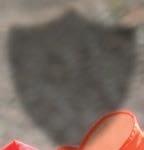
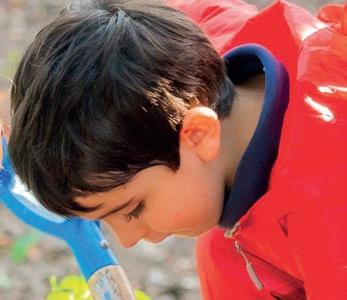



























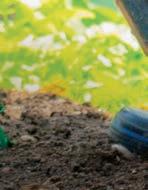



















































































Outdoor learning at Alleyn’s Junior School GREEN THINKING WHY GARDEN TIME IS SO VALUABLE FOR BUILDING CONFIDENCE AND SKILLS












































Writer and educator
With a background in EYFS teaching across Kent, Sophie David is an early years consultant, author, and the founder of the Little Happy Learners platform of resources for young children and their carers. In this issue, she talks about her new book on phonics, Read, Write, Play, and her broader mission to make early reading and writing playful, active and hands-on, so that adults and children can share enjoyable and productive time together.

Headmaster, Wycliff e College
Christian San José studied Geography at Oxford and trained at Sandhurst, serving in the Army within the Royal Green Jackets (The Rifles) before moving into education. He was at Radley for eleven years before being appointed Senior Deputy Head at Giggleswick School in 2021, joining Wycliffe as Headmaster at the start of the 2024 academic year. In our 60 Seconds profile, he describes his background and educational philosophy.

Co-founder, Turtle Tots
Caroline Sparks was a new parent when she and another new mum co-founded a swimming school with a difference in Bristol. The aim was to make swimming social, fun and suitable for each individual child, whatever their age and stage. Today, Turtle Tots' family-owned franchises in the UK and Ireland teach babies, toddlers and pre-schoolers to enjoy water and learn to swim. In this issue, she discusses how to ensure your child stays safe around the water.















Summer brings particular pleasures, and chief among them is time outdoors. There’s a resolutely alfresco feel to this issue to celebrate, and with many reminders of why we should cherish time in the green and pleasant – and why it is so very good for children to be in the open air.
Alleyn’s Junior School is certainly a champion of the outdoor life and our cover and Focus feature explore its approach to Forest School and the
Rules (from page 42). The most hallowed summer game is going through a growth spurt – with more girls and boys taking up the game thanks to playing pathways and media exposure. Speaking to Michael Powell at Rugby School for the feature, I was struck by a comment he madwe that so many elements in cricket mirror life –highs, lows, drama and reflection. These are elements children take on board naturally, learning lessons for life on and o the pitch.
Summer means time to explore and we have adventurous possibilities, from a pick of the best British campsites (page 72)
“SO MANY ELEMENTS IN CRICKET MIRROR LIFE –HIGHS, LOWS, DRAMA AND REFLECTION. THESE ARE
benefits that follow when pupils learn and explore beyond the classroom. Read more from page 16. We also explore the wonderful Hackney School of Food, a gamechanger for both school children and the wider community (from page 20). With the opening of its Garden Room, linking its walled garden with the kitchen hub, it’s a setting that really does celebrate the pleasures of growing, tending and eating fresh produce together.
Growing future batters, bowlers and wicket keepers is front of mind for the four schools we talked to for Cricket
to golden time on (arguably) the world’s best beach in Turks and Caicos (page 76). And don’t miss our visit to Billund, home of the world’s most famous play brick and a place to inspire young creators and engineers (from page 68). If you and your family aren’t journeying far this summer, there’s an escape in books. Our summer line-up includes adventure, intrigue and a whole host of unforgettable plotlines and characters (from page 62). Wherever you escape to, enjoy your summer break.
Libby Norman EDITOR
10 SCHOOL NEWS
Out and about in the world of education
13 CHELSEA GOLD
Francis Holland Prep earned a top prize for a floral 'Fearless Girl'
16 FOREST IMMERSION
An enriching Forest School programme brings learning to life at Alleyn's Junior School
20 GROWING MOVEMENT
Hackney School of Food's new Garden Room celebrates seed to fork and the pleasures of food
28 PHONICS FOR FUN
Sophie David's book gives parents and children a play-based approach to help make phonics stick
31 NURSERY CHOICE
The Founder of Phileas Fox shares pointers on choosing a nursery setting
32 WILD VIBE
Jess Hannigan's new book re-energises a classic tale about the dark wood
35 WATER CONFIDENCE
The Co-Founder of Turtle Tots on the importance of helping young children build skills in water


38 GARDEN TIME
Three preps share their approach to gardening – and the pleasures of growing and tending a school plot
42 CRICKET RULES
Summer's great game is going strong thanks to new formats and pathways. Four schools give their take on its enduring appeal
49 SMASHING
York House School on the importance of teaching our youngest children to be open minded and steer clear of stereotypes
55 60 SECONDS WITH...
The Head of Wycli e College, Christian San José, shares his background and educational philosophy
57 ASK THE EXPERTS
Expert answers on how to design an e ective summer tutoring programme and getting help for a child who can't focus in class








EDITOR
Libby Norman
GROUP ADVERTISING MANAGER
School’s Out
62 SUMMER BOOKS
From a rabbit's life less ordinary to adventures on the high seas, our pick of great reads this summer
68 ANOTHER BRICK IN THE WALL
A visit to a remarkable Danish town where the world's most famous play brick comes to life
72 CAMPING BEST
Our experts pick six of the best British sites, whether your taste is adventure or glamping
76 BEACH DREAM
Turks and Caicos is the perfect holiday on the ultimate white sands with Wymara
82 HOBBY TIME
Just how much should you commit to your child's hobbies?





Nicola Owens
MEDIA CONSULTANTS
Anna Clarke
Steve Playfoot
ART DIRECTOR
Pawel Kuba
SENIOR DESIGNERS
Suzette Scoble
MIDWEIGHT DESIGNER
Carmen Graham
MAGAZINE DESIGNERS
Mariana Suzuki
Pamella Moreno
PRODUCTION MANAGER
Danica Brodie
FINANCE DIRECTOR
Jerrie Koleci
CREDIT CONTROL MANAGER
Alexandra Hvid
DIRECTORS
Craig Davies, James Fuschillo
MANAGING DIRECTOR
Sherif Shaltout





From September, the International School of London will offer secondary students (11+) a Japanese language acquisition option, alongside French, Spanish and Mandarin. Head Richard Parker (pictured with teacher Tamako Matsukuma) says that this introduction sits alongside the 24 home languages already taught at the Chiswick school.
Feltonfleet’s Digital Prefects confidently demonstrated the school’s own AI-powered learning assistant, RileyBot, at a recent meeting of Pre Senior Baccalaureate (PSB) schools to discuss Artificial Intelligence in education. Leading discussion and answering complex questions, the Year 8 pupils showcased how pupil voice and digital leadership are shaping the future of education.


Wellington student Momo X has won a host of awards for his photography, now featured in his book The Art of Small He became fascinated by insects, at age five, and this led on to a passion for ‘ultramacro’ photography. At 15, he became the youngest Chinese photographer to be featured in National Geographic
Haberdashers’ Elstree Schools raised £190,000 for bursary and hardship schemes during a giving day in April. This year’s focus was on helping current students. There were fun runs, including the GivingDash to run 3.5km and unlock extra donor funds. Further MiniDash and TinyDash events took place for the youngest pupils.
A Stephen Perse Cambridge girls’ football team won the national Independent Schools Football Association U15 Girls Shield. A er securing epic victories in the first four rounds, the girls beat worthy challengers St Dunstan’s College 3-1 in the final.
Mill on the Brue offers lots of fun adventures, but it’s also celebrating its Zero Heroes food waste policy (no food waste a er meals), now running for over a decade. It’s one of many green initiatives, including a coach escort from London to Somerset for summer camps.




St Benedict’s School in Ealing has announced that, from September 2025, pupils in the Junior School will no longer sit the 11+ entrance exam for transfer to its Senior School. The school says this allows students to maintain momentum in learning and ensures a smooth, confident transition. The decision followed consultation with parents, who were overwhelmingly in favour.
Dulwich College hosted the national round for the international physics challenge, the Weizmann Safecracking Competition, this spring, – and its own team achieved fi h place in this tough event. With 21 safes entered by students from 16 different schools, the competition tests creativity, engineering skills and problemsolving abilities – also requiring exceptional teamwork.
Moor Park School recently staged a spectacular production of ‘Shrek the Musical JR’. for students in Years 6-8, bringing the characters of Shrek, Fiona, Donkey, and others to life with enthusiasm and professionalism. “The energy and enthusiasm from everyone – on and off the stage – was simply amazing,” says Head of Performing Arts Toby Dunham.

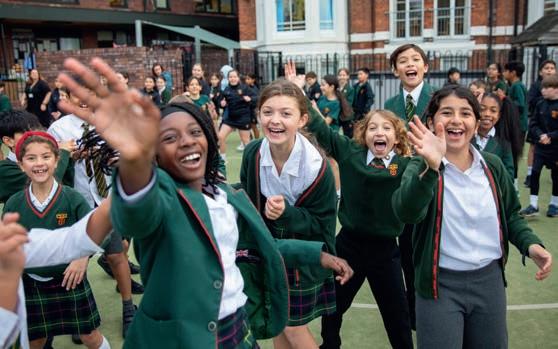
YOU CAN STAND OUT AT
of Queen Ethelburga’s, York
WHERE WE HELP YOUR CHILD be the best you can be with the gifts that you have



TO








SUPERB FACILITIES & CLUBS | SMALL CLASS SIZES | INDIVIDUAL LEARNING PLANS BUS ROUTES THROUGHOUT YORKSHIRE
Chapter House Prep School is an award-winning, co-educational day and boarding school set within 220 acres outside York. Welcoming children aged 3 months to Year 5 and boarders from Year 3.
24/7 PASTORAL SUPPORT | TWO LANGUAGES TAUGHT | ‘OUTSTANDING’ EYFS PROVISION

Francis Holland Prep’s floral interpretation of this year’s Chelsea in Bloom
‘Flowers in Fashion’ theme picked up a Gold, to the delight of pupils and sta in both Prep and Senior schools and the parent body. For this was very much a team e ort.
The starting point and inspiration for the design was ‘Fearless Girl’, a symbol and uno cial mascot of both Francis Holland

Prep and sister senior Francis Holland, Sloane Square, a short walk up the King’s Road. The design was inspired by Kristen Visbal’s bronze statue which stands in New York – an o cial replica is on display at Francis Holland, Sloane Square.
This wonderful floral version was covered entirely in moss and flowers, a book held firmly in her hand and wearing the school’s distinctive uniform of tartan skirt and navy jumper. Dressing the historic entrance to the Prep at 15 Manresa Road – once home to the Chelsea Public Library – the design incorporated dried, fresh, and handmade flowers. The handmade blooms were carefully curated by Francis Holland Prep pupils.
In late May, the school was delighted to hear that this bespoke design had not only won a prestigious Gold Award (only 14 out of 130 participants were awarded a Gold) but also a special mention for the Innovation Award.
The Chelsea in Bloom judges commented on both the creativity and the sustainability of the installation – particularly pupils’ handmade flowers, which were made from upcycled school
uniforms. The girls had chosen this approach to underline the vital importance of sustainable fashion.
The winning design was a real group e ort. FHS parent Lola Cavanilles, an artist, interior and flower designer, gave generously of her time and expertise, and many other parents, sta and pupils spent hours on the planning, design and final installation.
The school was especially delighted to be among the winners with so many other superb entries by Chelsea in Bloom participants. Following this success, Francis Holland Prep and Senior girls hope to take part in in many more local community events and challenges – and do so fearlessly.
“The outfit for this floral Fearless Girl incorporated dried, fresh and handmade flowers”


your child the best chance of success for the 4 Plus Assessments
Avoid the 7 plus or 11 plus stress by getting your child an all through offer to schools like Highgate, Alleyn’s or Westminster with the 4 Plus assessment. At Mentor Education, we 4 Plus experts and have helped hundreds of families over the past three years.
We offer:
• A proven 4 Plus programme created around your child
• 1-2-1 and group classes dependent on need
• Behavioural and academic sessions
• Experienced teachers from 4 Plus Schools
• Sites in Hampstead, Westminster and Dulwich
• Standardised maths and literacy testing with Cambridge University
• Standardised language testing with Oxford University
• 60—70% success rate vs a normal 10-20% success rate
• Capped student numbers
hello@mentoreducation.co.uk or 0208 883 2519
Find out more at www.mentoreducation.co.uk



GROWING MOVEMENT – SEED TO TABLE EXPERIENCES AT HACKNEY SCHOOL OF FOOD P 20

LET'S GO OUTSIDE
Forest School fun at Alleyn's Junior School Page 16
























Getting outdoors to build skills, confidence and independence in a natural environment is a regular part of life at Alleyn's Junior School. We speak to Forest School Teacher Heather Sandham to find out how this works and why this is such a valuable and creative learning environment






“Parents are overwhelmingly supportive of Forest School and value its role in balancing the digital demands of modern life”









How does Forest School work at Alleyn's and how is your space designed?
At Alleyn’s Junior School, Forest School is a fundamental part of our commitment to holistic, lifelong learning. Our reception children experience regular sessions in our dedicated outdoor space where activities are open-ended, often using natural materials and the environment itself as a springboard for creativity, collaboration, and critical thinking.
We are in a fortunate position where we are further upgrading our outdoor space to best benefit our pupils. The space itself will be carefully designed to reflect the six core





principles of Forest School. It is a wooded, natural environment that promotes supported risk-taking, independent exploration, and learner-led discovery.
One of the ideas behind Forest School is to take learning outside, so how do you then build its principles back into classroom learning and the school day?
Forest School values – independence, responsibility, problem-solving and resilience – don’t end when the session finishes. We consciously thread these principles through our classroom learning and they are seen in our seven learning
dispositions. Reflection is a key component of Forest School, and we continue this practice back in the classroom to support emotional literacy and self-awareness.
The autonomy and confidence pupils develop outside helps them to approach academic tasks with greater initiative, curiosity and perseverance. Forest School also reinforces our digital balance. While pupils engage with technology through our digital literacy programme and understand the wider e ects of AI through our AiQ curriculum, we ensure they also ‘switch o ’ and reconnect with the natural world, building focus and ensuring wellbeing.


What do you see as Forest School's chief benefits for children?
Forest School fosters growth in every sense – emotionally, socially, intellectually and physically. It is a unique environment, one in which children are the main decision makers, risk takers and are ultimately in control of their learning. Forest School builds confidence, resilience and self-regulation, and the unpredictable nature of being outdoors also teaches flexibility and encourages creative thinking.
Children become more aware of their environment and their responsibilities within it – towards nature, their peers and themselves. Ultimately, it equips them with skills that extend far beyond the woods.

“It is a unique environment in which children are ultimately in control of their learning”
How do Alleyn's pupils react to their outdoor learning time and freedoms?
Generally, pupils embrace Forest School with enthusiasm. Of course, as with anything unknown, some children take time to adapt to a new environment and find the prospect of making choices challenging. However, with guidance (both from adults and peers), pupils engage positively and enjoy the chance to lead their own learning. Pupils rise to

the challenge of navigating risk, solving problems and making decisions.
Whether guiding a blindfolded partner through a sensory trail or constructing a den from natural materials, they show immense pride in their achievements, which become more group orientated rather than individualised. Their joy in the freedom to play, explore and create is palpable, and we often see how this confidence carries through into other areas of their school life.
What is parents' view of the learning, play and fresh air that Forest School and outdoor time provides?
Parents are overwhelmingly supportive of Forest School and value its role in balancing the digital demands of modern life. As screen time becomes increasingly prevalent, many families are looking for ways to help their children disconnect and re-engage with the real world.
Forest School provides exactly that: a grounding, mindful space that promotes wellbeing and healthy habits. Parents often comment on the positive impact Forest School has on their child’s mood, focus and their enthusiasm for school.
alleyns.org.uk/junior-school

The opening of the Garden Room at Hackney School of Food means children and community can enjoy even more inspiring seed-to-table experiences
LIBBY NORMAN
There's something magical about Hackney School of Food – a growth mindset in its most literal form.
Tucked away in one of the most densely populated quarters of London behind high brick walls, it's a lush oasis centred on the pleasures of growing, tending, cooking and eating.
There's the School of Food, a kitchen where groups of children turn chef for the day and then dine together. There's the beautiful garden full of colourful ornamentals and an impressive range of edibles. And now there's the Garden Room, bringing education
about food and growing together in one light-filled space. In an era characterised by a doom loop approach to health education, this shows how to make such lessons lifea rming, inspiring and fun.
The Hackney School of Food started out in 2020 and sits on the same Oswald Street, Clapton site as Mandeville Primary School. Both school and cookery school are part of LEAP, a federation of three Hackney primary schools, and Hackney School of Food is run as a community interest company (CIC). This means it has a strong remit to reach out to local residents in an area underserved by green spaces and facing issues such as poverty, food poverty and obesity.
While not for profit, it opens its doors to the wider community through programmes and courses – to date over 7,000 children from nearly 60 schools from across London and beyond have visited the School of Food. Everyone benefits, but for the children of Mandeville Primary, this is their place –visible from the playground and accessible for all sorts of activities.
The Garden Room is a high-ceilinged and flexible teaching and meeting space with views over well-used playground on one side and green and verdant plot on the other. The garden is a miracle of inspired design and careful planting (Head Gardener Lidka D'Agostino certainly










"Shelter provided by the warm brick walls creates a microclimate perfect for wall-trained and freestanding fruit trees"


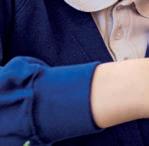












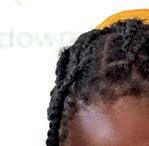

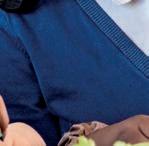




















help to keep the pests in check (although there is a bug hotel for the overwintering good doers). There's even a beehive under expert management by local volunteers.
knows her stu ). There's no corner here wasted but still a feeling of space to roam. All the more surprising when you learn that this was once a rather wasted area of playground – rarely used due to frequent waterlogging, says Mandeville School Headteacher Marc Thompson.
As a growing zone, it's perfect. Shelter provided by the warm brick walls and ring of buildings beyond creates a microclimate perfect for wall-trained and freestanding fruit trees and bushes – choice rarities such as jostaberry and medlar among them. Tomatoes can climb and ripen on the vine in this sheltered spot, while salad comestibles and herbs enjoy optimal care in the raised beds, having been nurtured from seed in the highly productive greenhouse. Happy chickens roam and
Everything in this space is child-centric, including the raised beds at child height, and the process of growing from seed –taught in the Garden Room and garden itself – continues on to tasting at the table. Young children tend to be suspicious about anything unfamiliar put on their plate by adults, but give them the opportunity to savour the di erences between sweet, savoury and bitter by sampling a morsel from the garden then learning the name of the plant and they become more receptive. And if they've grown something from seed themselves or seen it flourish in the garden, children become way more inclined to give eating it a go.
Head Food Educator Tom Walker and team carry this adventurous growth mindset from the garden and Garden Room through to the School of Food. Here, the rituals of preparing and cooking something delicious together

and then sitting down as a group to feast nurtures positive attitudes to food, and social time around a table.
The hub this has become for the community beyond the school gates can be seen in the activities programme. From sushi and breadmaking sessions through to masterclasses in compost making, it all happens here. Hackney School of Food also welcomes private and corporate bookings –and what a great space for an away-day.
Children remain at the heart, and young people across Hackney and far beyond can enjoy a fruitful half or full day in the kitchen and garden. Cooking classes cover everything from basic nutrition and safe knife skills to eating with the seasons. In the garden and Garden Room, they find out how to grow and tend, discover more about pollination and insects, learn about soil composition and improvement and consider really big questions – food miles and reducing the environmental impact of what we consume included.
These are lessons that, hopefully, will shape positive lifelong habits. Mandeville and other schools within LEAP can testify to the di erence it makes to the children. "They have a better understanding of planting, food production and natural life cycles as a result of this rich experience. We see the di erence every day," says Marc Thompson.
Hackney School of Food came about thanks to support at local-council and London-wide level, and from generous charitable trusts. It has influential champions – Chefs in Schools and Sainsbury's among them. Bringing the idea from seed to fruition was a triumph. Let's hope it becomes a blueprint for other schemes, and for all that can be achieved when you create a space where children go on that journey from seed to fork – and enjoy the pleasure of food grown, cooked and eaten together.
hackneyschoolo ood.com



Outstanding education in an inclusive, warm and dynamic environment for girls and boys aged 3-13 in Ealing, West London.
Open Day • Saturday 11 October
Private Tours available throughout the term
Places available for Reception 2025 & Year 3 2025

Alex Murphy, Deputy Head of St Dunstan’s College Junior School, on how this award-winning prep prepares young people for the world of tomorrow
In independent education parents, understandably, want to see value for money. With rising fees driven by VAT changes and a cost of living higher than many have ever known, the return on investment in private schooling is under greater scrutiny than ever. Schools often point to league tables, exam results, and university destinations to highlight their success, but do these metrics tell the full story? And are they overshadowing something just as important – the development of the individual?
Academic achievement matters. It equips children with the knowledge and skills to access broader opportunities beyond school. Yet on its own, it is not enough. Without the ability to think critically, collaborate and
self-reflect, academic results risk becoming hollow credentials. Today’s employers are less interested in specific exam grades and more focused on whether young people can learn independently, adapt to change and lead with confidence and integrity. Given the unpredictability of the future job market and the rapid pace of change, two skills stand out in particular: critical thinking and problem solving.
These human and cognitive skills aren’t easily measured. They don’t fit neatly into a spreadsheet or performance report. Instead, they are embedded in classroom interactions, pastoral care and the broader educational ethos – from the earliest years onward. Schools that embed this philosophy early on, rather than waiting
“A RICH CHARACTER EDUCATION NURTURES EMOTIONAL INTELLIGENCE, MORAL AWARENESS AND A SENSE OF PURPOSE”
until secondary education, are becoming increasingly attractive to families. More parents are choosing schools not just for their rankings, but because the school’s values resonate with their own.
Junior school pupils are at a formative stage. Every interaction – whether it’s navigating a playground disagreement or reflecting on a mistake – shapes their character. These early years are when empathy, resilience and integrity take root. If schools focus solely on academic benchmarks, they risk producing highachieving children unprepared for life’s complexities. Schools that recognise this and adapt their curriculum to include life and metacognitive skills give children the space to forge their own path. They help them find their voice, understand who they are and build the character needed to make a meaningful impact beyond education. A rich character education nurtures emotional intelligence, moral awareness and a sense of purpose. These qualities matter just as much as grammar or times tables.
These qualities must not be treated as tokenistic extras. When integrated fully into a learning journey, they help children discover who they are, what they value, and how they can contribute to the world. That is the true value of education and the greatest return on investment.
Find out more about St Dunstan’s College Junior School at stdunstans.org.uk







































Early years specialist Sophie David is on a mission to demystify phonics with her latest book – and ensure children and parents have fun together

Mention
phonics to many parents and their eyes glaze over.
It’s something Sophie David saw as a teacher and specialist in early-years – the parent confused about what they actually were or worried about saying sounds wrong. It’s one reason she’s on a mission. “We need to change the narrative with learning to read and write,” she says. “Let’s try and embed as much play into our learning as possible.”
This is the approach that underpins Read, Write, Play – a comprehensive guide to phonics, but delivered in a way that’s accessible, practical and engaging for children and parents. It’s structured by age and phonics phase. The projects are simple, and come with excellent visual and written instructions – a lot of thought has gone in to creating such clarity. Ask how long she took to devise it and there are two answers. “The book has been in development for years, since I became a teacher! To write it has taken about a year.” It is a brilliant distillation of tested approaches – ones she’s used in her work and at home. In fact, the children in the photos are her young sons and daughter.
Read, Write, Play may have been created by a teacher, but it feels nothing like a school day. Usefully, it starts at beginning with Phase 1 phonics (age 2) and goes all the way up to Phase 6 (age 7). Phase 1 is all about games to support listening – the foundation of understanding how letters sound and being able to replicate them. By Phase 6, there are activities to help with reading practice, comprehension and spelling.
Originally, Sophie David’s publishers suggested the book should leave out Phase 1, but she argued the case. “Phase 1 phonics encompasses everything. It encompasses speaking and listening. It encompasses opportunities for sharing,
opportunities for really exploring sounds,” she says. “We need to start where that process begins for children.”
The other reason Sophie David wanted Phase 1 in is because not every child develops at the same rate. Always so, but right now it’s recognised that there’s increased incidence of speech and language delay. The jury’s out on why – a Covid after-e ect, screen time or multiple factors – but more children need some support. “I want every child to be able to access this, not just the neurotypical child,” she says. That’s also why there’s a set of images at the back, modelled by her daughter and showing the way our mouth should look when we make di erent sounds – extra expertise was provided here by a speech and language therapist.
While parents who would like guidance can dig deeper, the main body of the book delivers fun ways to help make phonics stick, so a great dip-in resource for those parents who just want some projects to try with their child. “One thing I wanted to get across is encompassing all parents, especially working parents. I just wanted to make the ideas

“If you’ve got a pack of plastic cups in your cupboard you can do at least 20 of the activities in the book”
accessible,” says Sophie David. “If you’ve got a pack of plastic cups in your cupboard you can do at least 20 of the activities in the book.”
The mix of ideas is varied to suit di erent timescales, ages and moods – and with lots of quick activities. Usefully, many of them, such as a treasure hunt in search of objects around the house, also burn o energy. “Sitting at desks and writing in a book is not the best way to learn, so I wanted to incorporate as much movement as possible.”
And, for the many parents who worry that their child is incapable of sitting still at all, Sophie David has welcome reassurance. “Typically, a child’s attention span is two minutes for every year of their life. So, if they are four, on average they should be able to concentrate for, say, six to eight minutes.” She’s keen to stress that this really does vary from child to child and also, importantly, children don’t just magically transform into beings who sit down and focus when you ask them to.
“Parents need to know that this attention span and the time that they’re giving their children, it doesn’t just start,” she says. “What we have to start doing is building these little windows of fun and attention with games and listening activities so that it builds their attention span over time.”
Read, Write, Play is the perfect way to start building that attention span with activities that children will enjoy. Best of all, they won’t think of them as learning because they are interacting and playing with you.
Sophie David is a great fan of homebased play – she reckons it’s often more memorable for a child than an expensive day trip or carefully planned activity. “One thing your child wants is your time. The entire premise of what I do is trying to build these moments of connection.”
* Read, Write, Play by Sophie David is out now (Robinson, £22). For more of her play-based learning ideas, visit littlehappylearners.co.uk
















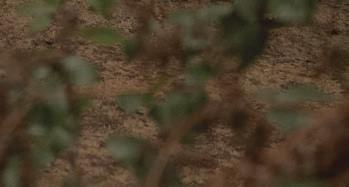
Evgenia Lazareva, Founder of Phileas Fox Nursery in London’s Little Venice, on key areas to consider when choosing that first vital educational setting

ABOVE
“Ask yourself why you want to send your child to nursery – this informs the type of setting you need”
Choosing a nursery for your child is an exciting first step in their educational journey, but it can feel overwhelming. A good nursery can work wonders for your child’s development, instilling fundamental skills for lifelong learning, so it’s important to allow plenty of time for research and visits to make the process smooth and rewarding. Here are practical tips to help with the choice. Define your priorities Start by asking yourself why you want to send your child to nursery. Is it for childcare as you return to work, to prepare them for school or to give them socialisation opportunities? Understanding your primary motivations informs the type of setting you need. Some nurseries are open year-round and accept babies, while others admit children later and have strong ties to prep schools. You might prefer bilingual settings, Montessori or forest schools. It can be hard to find a nursery that ticks every box, but having clear priorities helps narrow your shortlist. Begin your search Start looking within your local community. Local parenting
groups – whether on social media or in person – are information goldmines. Many parents have navigated this exact process and are happy to share their experiences and recommendations. However, what works for one family might not work for another, so make your shortlist around your key preferences. Do keep an open mind, as you may find that a nursery you hadn’t initially considered becomes your top choice.
Arrange a visit If the essentials such as opening hours, holiday schedules and fees fall within your expectations, book a visit. No online reviews compare to seeing a nursery in action, meeting the leadership team and asking questions directly. During your visit, pay special attention to the sta and their interactions with the children. Also find out about qualifications and experience of the team and study the environment – is the space clean and well-organised with age-appropriate and stimulating resources available?
Look at the outdoor space, too, and ask to see where children nap. Finally, find out how the curriculum is delivered, how much individual attention each
child receives and what regular planned activities take place. How is progress tracked and what measures does the nursery use to ensure school readiness? Practical Elements come into play. Ideally, your nursery will be within walking distance from home or on your route to work. However, exceptional nurseries may be worth a longer commute if logistics allow. Consider session times and flexibility. It’s particularly important to know if the nursery will accommodate early drop-o s, late pick-ups and ad-hoc requests. After each visit, listen to your gut feeling. You might know you’ve found ‘the one’ or have a few excellent options. Weigh up the pros and cons and arrange another visit if needed – particularly valuable if your initial visit was some time before your child’s proposed start date. The right nursery will nurture your child’s confidence, fostering play, growth and a love of learning. Taking time to choose ensures that first experience sets down a firm foundation for future learning success.










Canadian author-illustrator, Jess Hannigan's bold take on goings on in the dark wood is funny, visually stunning and just a bit subversive


















Living in Ontario, Jess Hannigan is way more familiar with bears than many of her readers, but the large furry presence in her new picture book, The Bear Out There, is the opposite of alarming – rather reassuring, in fact. For this is a tale that neatly twists the Goldilocks plotline – and it is very funny indeed.
It’s the second picture book for the Hamilton-based author and illustrator – her first, Spider in the Well, featured a much smaller beastie, plus deliciously wry jokes about outrageous fibs and cons and a great quest for justice. These are plotlines for children to relish – and adults enjoy the jokes too. So does she write for this twin audience? “I do try and make fun for kids and adults because you don’t want the adult to go; ‘oh god, not this one again’.” she says. Hannigan’s love of playing with conventions began while she was at art college – in fact, a short and delightfully silly animation shared on her Instagram feed was the idea that led on eventually to The Bear Out There. Often illustration ideas start things o , but this book began with the dialogue – that classic theme of scary things out there in the darkness.
Pictures and design took over as she imagined her characters, and she started out with that most traditional art technique, collage. It’s what makes the illustrations leap o the page. Although they were painstakingly scanned afterwards, it was paper, scissors, glue to start with (a process Hannigan has also shared via a short film on Instagram). A truly oldschool messy process in our digital age, but that’s the point. “Spider in the Well was all done digitally, and most of my freelance work is all-digital as well, so I thought: ‘what is something more tactile that I can do that isn’t going to make me hate my life and regret my decision?’”
Hannigan has done plenty of fine art and large-scale canvases in her time, but as she developed her style as an illustrator, she instinctively began to pare back. “My work just got simpler and simpler as I found that this was more satisfying,” she says. “I lose interest quite quickly if there’s too much going on.”
She’s been inspired along the way by legendary names – The Big Hungry Caterpillar’s Eric Carle for one. “I’ve seen videos of Eric Carle walking through his process, and he just looked like he was having a blast painting his big sheets of paper.” She particularly


“NOT CARING TOO MUCH ABOUT CUTTING UP THE PERFECT PIECES –IT LENT A LOT OF FUN TO IT AND A BIT OF NAIVETY.”

enjoyed watching the freedom in his technique. “Not caring too much about cutting up the perfect pieces – it lent a lot of fun to it and a bit of naivety.”
She’s also a fan of other great names. “I always come back to Tomi Ungerer because of the way he lays out his page and the fun in his jokes and his characters,” she says. “And I really love Tar Gomi, the Japanese artist who does so many beautiful board books. He kind of has the brain of a designer, so I gravitate towards these design-brain people as well.”
Jess Hannigan taps into design-brain approaches herself, creating extensive mood boards as a starting point for projects – often these are on Pinterest. “Posters, lettering design, characters, sometimes it’s pictures of real animals,
but rarely.” There’s abstract art in there if colours or shapes grab her. “Once I make that mood board, I never look back at it again – I just say, ‘OK, this is the vibe’.”
And there’s a truly wild ‘vibe’ in The Bear Out There – vivid colours, retro lettering and tantalising glimpses into that dark and threatening forest to keep the reader guessing. The predominant colour palette (lots of bold pink, green, orange) has massive child appeal, and was chosen because they were the shades she was into at the time so she wanted to have some fun working with them. There is, too, the fun of a surprise plotline – children love to be surprised (again and again). She has fond memories of her own childhood bedtime stories, especially Jon Stone’s The Monster at the
End of This Book. She recalls her mother getting into character with a di erent dramatic take each time she read it out loud and wanted to create that sort of energy, that magic. Early reviews of The Bear Out There from friends with children say she’s pulled that o . Her next picture book is already underway. No conventional fairytale beasties next time as it’s about a cow, for she has always loved drawing cows. Another book to look forward to – and surely many more to follow – for Jess Hannigan’s creations bring bags of energy and visual magic to delight readers of every age
The Bear Out There by Jess Hannigan is published by HarperCollins Children’s Books, (£12.99). Find Jess Hannigan on Instagram at jess.hgn





BOARDING FROM AGE 7 TO 18
FLEXI, WEEKLY OR FULL OPTIONS AVAILABLE
A WELCOMING HOME-FROMHOME FOR PUPILS TO GROW, ASPIRE AND ACHIEVE
A SPRINGBOARD FOR INDEPENDENCE, FRIENDSHIP AND OPPORTUNITY
Boarding at Framlingham offers stability and continuity in a welcoming home-away-from-home environment. Our Flexi, Weekly and Full boarding options are tailored to suit the needs of the modern family. From age 7 (Year 3) at our Prep School to 18 (Year 13) at our Senior School, our boarding provision provides a vibrant, supportive environment where every pupil can grow, thrive, aspire and achieve.
START YOUR CHILD’S JOURNEY TODAY
Spaces available for September 2025 and beyond. Discover Framlingham College on one of our Open Days or book a private visit today. Visit framlinghamcollege.co.uk/openmornings, contact admissions@framlinghamcollege.co.uk or call +44 (0) 1728 723789.





The Co-Founder of swim programme Turtle Tots on why it’s vital young children gain confidence and skills in the water as early as possible
There has been a concerning rise in the number of children in the UK who are unable to swim.
Various factors, such as limited access to swimming lessons and pools, increased screen time, the impact of lockdowns, and increased parental anxiety, have all contributed to this trend.
Swimming is not just a fun activity but a vital life-saving skill – drowning is a leading cause of accidental death among children. With the long school summer holidays ahead, there are some steps parents can take to support their child, even if they have a fear of water, to build essential water safety skills.
A child’s fear of water can stem from various sources – from lack of exposure and negative experiences to watching school friends or adult relatives who are anxious around water. Acknowledging and validating your child’s feelings is the first step towards helping them overcome fears. Discussing their worries openly will also foster trust and

“If your child sees you enjoying the water, they will be more inclined to give it a try themselves”

encourage a positive attitude around the prospect of learning to swim.
That said, it is important to start slowly and always in shallow water where your child can comfortably stand. Allow younger children to play with toys and splash water, then gradually introduce them to deeper water as confidence grows. Well-fitted swimwear will make swimming much easier and enhance confidence, while sleeved swimwear and swim hats protect your child from the sun if they are on holiday or swimming outdoors. Goggles help children to see underwater and reduce worries around getting water in their eyes.
The first step is getting an anxious child into the pool. Following this, positive reinforcement is key to helping them to feel empowered so that they associate the experience with fun and enjoyment. Trying some simple breathing exercises may help children to manage their anxiety before getting into the pool. Once you are in the water, celebrate the small victories. Praise your child’s e orts and encourage them to keep on trying.
Children look to adults for reassurance, so positive role modelling is critical. If your child sees you enjoying the water, they will
be more inclined to give it a try themselves. Age-appropriate professional swimming lessons are also a great way to boost your child’s confidence and technique
Teach them to float Floating is a life saver, allowing children to conserve energy if they ever get into di culty. Swim together Teach your child to swim with friends or family, never alone. Stay safe Remind them to stay within marked swimming zones and never wade, jump or dive into unfamiliar waters. Check local conditions Teach your child the di erences between calm and rough waters and to respect currents, tides and waves.



South London's leading co-educational day school



































































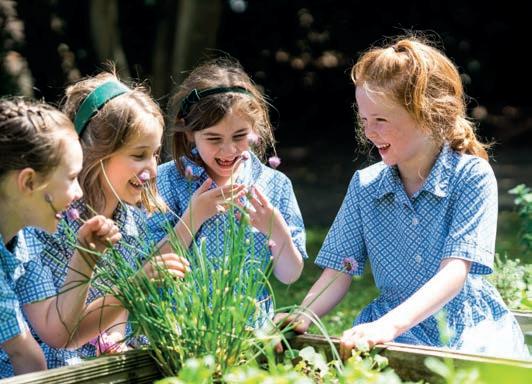
From
observing the seasons to growing and tending plants, outdoor crafts and creating wildlife habitats, school gardens are a place for learning, contemplation and fun. We speak to three schools about how they manage garden time
Set within 23 acres of Su olk countryside, Framlingham College Prep School o ers its pupils plenty of freedom to play, explore and learn. The ‘hands, heart, head’ learning approach here recognises how children learn best. Connections are made first through their hands, via play and exploration. Then they make an emotional connection with their discoveries. After that, they use their heads to think creatively and critically. This approach enables children to explore independently and start to make links in their learning.
Throughout the academic year, the curriculum supports learning outside – no matter what subject or age group. From the Year 6 to 8 sessions learning camping skills and woodland crafts in Forest School to biology lessons at the College beehives for Year 4 and 5 pupils. Meanwhile, Early Years children begin their outdoor learning journey with insect counts and pond dipping. Framlingham College Prep believes that giving children the opportunity to appreciate nature helps them to
grow in confidence and independence and also develop a greater respect and understanding of the world around us.
The school’s Junior Duke programme – described as ‘rather like a mini DofE’ –o ers opportunities to develop di erent skills and nurture essential qualities. Skills learnt range from bushcraft and den building to gardening and mapping.
Sustainability is a critical element and, since 2021, Framlingham Prep pupils have planted 420 trees across the school grounds in partnership with the Woodland Trust, also creating hedgerows to support habitats for native wildlife – these then become study zones.
The popular gardening club works to support insect and bee populations, and each year young gardeners take a selection of their green-fingered creations to the Su olk Show, last year winning Highly Commended in the school garden display class. The benefits of gardening and outdoor learning are critical for this age group, says the school, and range from improved motor skills to physical and mental health.
For some young children, outdoor learning can be daunting at first, but most pupils show
curiosity rather than fear. Being outside brings a feeling of freedom – to ask questions and speak openly without anxiety. Activities such as tending beehives or campfire lighting may bring some apprehension initially, but the school’s approach fosters open-mindedness and risk awareness while embedding valuable academic and life skills.
The school garden at St Chrisopher’s The Hall is a happy and tranquil space created by pupils themselves as part of a lunchtime gardening club and in celebration of the Beckenham, south London school’s 130th anniversary. It’s a small but much-loved corner of the school, nurtured by children who have taken real ownership of its upkeep. Over time, it has become not only a place of planting but a calm retreat where pupils go to sit and read, reflect or simply enjoy nature during class breaks. While the school has access to many beautiful outdoor spaces nearby for nature walks, play and exploration, the garden is unique as a space designed by and for the children learning here.

St Christopher’s views outdoor time as o ering a valuable place to decompress, and the garden is especially valuable for pupils with SEN and those younger children who sometimes become overwhelmed in classroom settings. The sensory experiences of gardening – touching earth, smelling herbs, hearing birdsong – create a calming and grounded environment and pupils report that it helps them feel more focused and relaxed for the rest of the day.
The school’s most exciting recent project has been lavender planting across the garden. The children are learning how to care for and nurture the plants throughout the seasons, with the purpose of harvesting the lavender beds to create handmade lavender bags. These will then be sold at the school’s summer fair as part of an enterprise project, helping children learn about sustainability, small business skills and the full growing cycle from seedling to sale. It’s a practical, purposeful project that has sparked enormous enthusiasm.
Pupils are generally very positive about gardening – especially when they see real results, such as a flower they planted themselves start to bloom. For new gardeners, there may be initial reservations about worms and mud, but those vanish quickly once they get stuck in and start to have fun. The gardening club helps to model curiosity and resilience, and children support each other in overcoming initial hesitation or squeamishness.
St Christopher’s The Hall school garden has become a natural extension of the curriculum. From understanding plant biology and lifecycles in science to measurement and data collection in maths and storytelling inspired by nature for English, the outdoor setting provides

ABOVE
Gardening jobs at

BELOW
Watering time at St Christopher’s
learning opportunities. In particular, the lavender project ties into both science and enterprise learning, encouraging children to think critically about where things come from, how they grow, and the environmental impact of choices we make every day.
Set within 25 acres of green space in Cobham, Surrey, Feltonfleet has an expansive campus. This enables learning to spill naturally from classroom into the great outdoors.
Outdoor education is woven into the fabric of daily life. From sowing seeds in gardening club to harvesting vegetables in Forest School, pupils learn how to nurture plants and also care for themselves, each another and the world around. “The natural environment is a living classroom,” says Forest School teacher Anne Mossop. “It sparks creativity, builds resilience and cultivates a deep respect for nature.”
Weekly Forest School sessions take place for Pre-Prep pupils in all seasons. Pupils learn how to climb trees, cook over an open fire and develop craft skills. A recent Year 2 session saw pupils using the Japanese art of Hapa Zome, or leaf bashing, to create colourful mirrored prints. The conversations that followed about symmetry and colour change gave a snapshot of how outdoor learning helps to build core academic understanding.
Gardening club o ers a deeply sensory
experience. Pupils dig, plant, water, and wait. In doing so, they develop patience, responsibility and persistence. Feltonfleet finds that tending to plants encourages empathy and collaboration – and there’s the joy of tasting a tomato or strawberry they’ve helped grow at the end of it all.
All pupils benefit from daily access to outdoor space, with the majority of classrooms opening directly onto gardens and play areas. Regular engagement with the outdoors supports gross and fine motor skills development, nurtures confidence, and encourages independence. Whether it’s threading cereal hoops for bird feeders or creating homes for woodland creatures, younger pupils learn through purposeful play. For older pupils, outdoor time o ers valuable space to unwind and connect, be it in playing energetic ball games or tackling adventure play areas.
The wider school site is designed to provide outdoor variety, with quiet reading gardens, treehouse hideaways, wildlife ponds and woodland trails among the areas to be explored and enjoyed. This variety means every child can find their favourite spaces and spend valuable time there in activity or quiet reflection. In 2024, Feltonfleet’s ‘Roots for Tomorrow’ tree restoration project was launched to protect and regenerate the school’s green boundary, strengthen biodiversity, and deepen pupils’ environmental awareness. It reflects the school’s belief in sustainability and responsibility – not just for today’s learners, but for future generations.

It may still have an image of village greens, fine teas and leather on willow, but cricket feels anything but sleepy for a new generation of boys and girls. Four schools tell us why it is such a brilliant school sport – and why it endures
Cricket may have a reputation as that most traditional of English sports, but there’s been a steady evolution – some would say revolution – in the game. New formats, the recent rise of girls’ and women’s cricket, plus the growing allure of the game across multiple continents. Its reappearance in the Olympics in 2028 in a T20 format (after a 128-year gap) will only add to its appeal and boost player numbers.
Grassroots starts young, and at Berkshire prep school Ludgrove there’s a sense of a whole landscape to discover as boys are introduced to the game. “It’s a culture,” says Gabriel French, Head of Drama/Performing Arts and also Head of Cricket. “Cricket is played through the year – it’s not just something that happens in the season.”
Ludgrove maintains a time-honoured tradition that all teaching sta get involved in coaching. “It does give us a di erent perspective of the boys,” says Gabriel French. “Very often you see a very di erent child, thriving in a very di erent way.”
Hailing from the Southern Hemisphere, he can well recall arriving at the school to see boys playing their version of cricket in the snow. “There is a wonderful game called stump that has been played since the school was started, pretty much,” he says. “As soon as they’ve grown out of a bat or a bat is broken the boys take it through to the woodwork store and the Head of DT, who is very much a woodworker, will cut o the sides and then they will use that in the morning game. It’s not unusual for a third of the school, 60 boys, to be down there in the morning playing stump.”
Ludgrove boys play cricket all year round, but anticipation rises palpably as summer approaches. “It’s such a big part of the school. You’ve got this big bank of nets and at break time nearly all of the school is out there playing. It’s just the most magical sight.” There are aspirations among many of the boys to be chosen to go on one of the school’s cricket tours – something to aim for. But for every level of ability and enthusiasm, there’s a sense of what Gabriel French describes as “pulling together”.
Children also love the whole ecosystem around the game – the history, rules, traditions. Gabriel French believes this plays

“At break time nearly all of the school is out there playing – It’s just the most magical sight”
a big part in its ability to draw children in. “Football is loved by so many because of its simplicity, whereas cricket seems to endure because of its complexity. Once you scratch the surface you just keep on finding areas of interest.”
Complexity certainly plays a part in the game’s allure, agrees Bedford School Director of Cricket Gary Steer, but he also thinks the respectful way it’s played counts. “It’s important, as well, that it’s played in a certain way. I think that’s even wider than just the game of cricket itself. There is a certain etiquette in cricket that can be spread in to other areas of life.”
At Bedford there’s a framework that supports players of every ability. “We have teams from Year 3 right up to the first team. Years 3 and 4 are soft ball cricket and hard balls are in use from Year 5 upwards. Each


























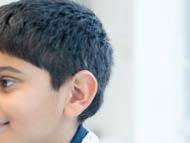




year, we have at least four or five teams at each age group. Everybody who wants to play cricket will get a game of cricket.”
As a former player for Derbyshire CCC, Gary Steer is enthusiastic about the potential new formats bring to widen cricket’s appeal – it certainly drives enthusiasm among boys at Bedford. “They see it on TV and see the kind of shots that they want to play.”
The fact that this is the style of game that will be in the Olympics bodes well for those who love the format and want to take cricket further, but Gary Steer is also confident that the game o ers much more.
“Basically, you can go wherever you want to with it. Those who love it and are really good at it can go on and have a career. For those who love the game but aren’t quite good enough, there are other roles,” he says. “You can be involved with cricket as a player or in other areas – such as umpire or coaching – for a very long time.”
Bedford School is doing its bit to grow the game, and its partnership with Northamptonshire CCC supports upcoming talent and helps the next generation of cricketers to play of their best.
Gary Steer thinks the game o ers something unique. “One thing that probably attracts a lot of people to the game is that there are a lot of skills involved,” he says. “Most boys – and girls – can probably find a role within the team.”
Reed’s is also helping to grow the game and Head of Cricket Chris Boyle is proud that the school typically fields 24 teams in the summer. That includes two girls’ teams made up of those who join the school at Sixth Form. “That’s only going to get stronger as we’ve got girls coming in who play cricket to a decent standard.” Lower down the school, students are supported in raising their game with one-to-one sessions with coaches – and any level of cricketer can book a session and work to improve technique.
That ability to strive as an individual to help the team is vital to the game’s popularity, but Chris Boyle says another great selling point is the social side. “The boys and girls are playing for local clubs, and they play against each other on a regular basis outside of school.” He thinks it’s important that cricket maintains its variety of formats, not least because each o ers di erent opportunities and suits di erent talents. “The shorter the format the less the opportunity for players to


contribute. Generally, not so many people bat if you are playing 20 overs, so I think a mix of format is a good thing.”
Certainly, at Reed’s the longer competitive games, played on the school’s ‘Big Side’, are a huge draw for the school and a lot of pupils will come out to watch the action unfold between lessons. There’s a real pride in being part of a team that plays on this hallowed space. “It holds a lot of value within the school,” says Chris Boyle.
“There is a certain etiquette in cricket that can be spread into other areas of life”
Another highly valuable asset in fuelling interest in the game is data, with easily accessible stats on who’s playing and how they are doing. “You can be with an A team and they know who scored runs in a C team while the game is going on.”
Ultimately, cricket is a great survivor because it continues long after school, says Chris Boyle. “You can find your level and keep going for a long time,” he adds. “Children can play with their parents in a team and maybe in 20 or 30 years they will be doing the same with their children.”
Michael Powell, Director of Cricket at Rugby School, sees another really engaging element in cricket happening now. “If we talk about the traditions and history, this is what is really exciting about the girls’ game now. Of course, the boys’ and men’s game is steeped


in probably 200 years of traditions. But you’ve got girls coming into the school now from really competitive families. They’ve got parents and grandparents who have played the game and you can see cricket is part of their family life.”
As a former Warwickshire CCC Captain, Michael Powell also knows the power of heroes to engage younger players.
“Selfishly, from Rugby School’s point of view, it really helps having someone like Maia Bouchier as a former student of the school. She’s just outside the England team at the moment but she’s performing brilliantly for Hampshire,” he says.
“We’ve got that in the boys’ game with Jacob Bethell, so having two England internationals that were in the school in the last five years makes a massive di erence.”
“Cricket combines the drama, the flair, the patience – I've always felt it mirrors life”
If future pathways matter, so do the foundations – one great benefit of cricket’s increasing visibility is having an influence on primary and junior sport. “You don’t have to go back too far and all prep and primary schools were playing rounders –now they are playing cricket.”
The rise of girls’ cricket is great news, but Michael Powell believes it remains a harder path at the moment. “If you took a very talented under 13 boy and a very talented under 13 girl joining

the school, the pathway for the girl to get to the top is probably higher than it is as a young male cricketer. But that in itself is fast evolving. There are more and more girls playing the game, which will drive competition, and competitive opportunities.”
Of course, for the vast majority of students, the game is there to be played for enjoyment, and for the team, and that ensures its broad appeal. “The lifeblood of the game is the new generation coming through now,” says Michael Powell.
“Obviously, it’s your Jacobs and your Maias that are in the spotlight, but I think the most pleasing thing for me personally as a Director of Cricket is how many boys and now girls come back to the school and play for our Old Boys’ side and soon to be Old Girls’ side. And they are involved in cricket – be it at university, at a club or for charity.”
Ask why cricket keeps evolving and why it endures and Michael Powell has a good answer. “The kids look forward to the game and then they reflect on the game gone. There will be highs, there will be lows, just as there are in a family,” he says. “I think it’s the variety involved in the game – the chance for you to shine, the chance for you to show your skill within a team environment. Cricket combines the drama, the flair, the patience – I’ve always felt it mirrors life.”

Mike Gedye of York House School on the importance of overcoming stereotypes from the earliest years of education
Challenging stereotypes among primary-age children is crucial in fostering an inclusive environment that promotes diversity and respect. By addressing and dismantling past stereotypes, educators help children to recognise the value of di erences in gender, race, ability and other characteristics. This helps to prevent the formation of biases that lead on to discrimination and exclusion.
At York House we use ‘Think Equal’ in our pre-prep, a programme that delivers social and emotional learning and challenges a discriminatory mindset. Curriculum design and resources are inclusive across the school – for instance, with books, stories, and resources that show diverse roles across genders. When having conversations with younger children, using gender-neutral terms – such as lunch sta – is helpful, too.
There should always be zero tolerance on misogyny, and coaching teachers to ensure they model non-stereotypical attitudes themselves helps avoid these in the classroom. In PSHE, our pupils are exposed to di erent careers, roles and responsibilities and these are regularly discussed from a gender viewpoint. As PSHE is a spiral curriculum, the issue of careers, roles and responsibilities is revisited each year in greater depth.
Role play activities are an excellent way of dispelling stereotypes. Allowing children to try out di erent professional roles in a
“Early intervention encourages critical thinking, enabling children to appreciate diverse perspectives”

classroom performance or during drama sessions, can be particularly impactful. ‘See Think Wonder’ activities – where images are presented of people who would traditionally be assumed to be a certain gender – supports this. Pupils describe what they see and develop an idea of what they think based on this first impression. Initial assumptions are then challenged by asking deeper questions.
Role modelling is key. Notably, boys and girls should have access to all sports. As educators we need to be instilling a culture where this is accepted as ‘normal’ despite traditional views on certain sports. By the same token, within the school setting, we can help to ensure a balance of genders in positions of responsibility across the sta and student community.
A visible diversity and inclusion team ensures the processes in school are always challenged – and it’s helpful to get pupils involved. We have launched a Kindness Council here at York House. Kindness Captains have been voted for and now
pupils meet to discuss how we can become more inclusive. We also try to emulate this when inviting external guest speakers into school, making sure we include professionals of di erent genders in a range of roles.
Early intervention encourages critical thinking, empathy and open-mindedness, enabling children to develop positive relationships with their peers and appreciate diverse perspectives. This not only enhances social cohesion within the classroom but also prepares children to navigate and contribute to a more equitable future.






Dulwich prep and nursery Rosemead is celebrating a host of recent award nominations and accolades
Rosemead Preparatory School and Nursery, Dulwich, is thrilled to announce it has received seven nominations at the prestigious Education Choices Awards 2025. The achievement of seven nominations highlights the thriving south London school’s continued commitment to excellence, inclusivity and innovation.
ROSEMEAD HAS BEEN SHORTLISTED IN THE FOLLOWING CATEGORIES:
- Improvements in EDIB (Equality, Diversity, Inclusion and Belonging)
- Developing School Partnerships
- Developing Student Voice
- Enveloping EDI in the Curriculum
- Opportunities in Art and Music
- Inclusive SEN Provision
- Diversity and Inclusion in Sport
These nominations follow on from Rosemead’s success at last year’s Education Choices Awards, where the school won the Improvements in EDIB category. Last November, Rosemead was also honoured with the Excellence and Innovation in Equality, Diversity, and Inclusion award at the Independent Schools Association (ISA) Awards. More recently, the school has been shortlisted for Independent Prep School of the Year at the upcoming Tes Schools Awards 2025 – a further testament to its sector-leading approach.
Speaking about the news, Rosemead Head Graeme McCa erty said: “This recognition is a real testament to the hard work and dedication of our sta , pupils and wider community. At Rosemead, we believe in creating an environment where every child can thrive – academically, creatively and personally.
“ROSEMEAD IS A SHINING EXAMPLE OF WHAT IT MEANS TO DELIVER EXCELLENCE"
“These nominations reflect our commitment to building a truly inclusive, empowering and forward-thinking school.”
Rosemead is part of the St Dunstan’s Education Group, and its CEO Nick Hewlett, added his praise: “Rosemead is a shining example of what it means to deliver excellence, di erently. These nominations reflect the school’s deep commitment to inclusion, creativity and character education – showing that exceptional outcomes are achieved not through tradition alone, but through values-driven, modern and courageous practice.
“We are incredibly proud of what Rosemead continues to achieve.”
To find out more about Rosemead Preparatory School and Nursery, visit rosemeadprep.org.uk

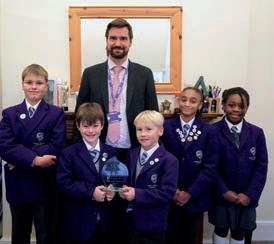
































“WE ARE THRILLED THE INSPECTORS SAW WHAT MAKES ST CHRISTOPHER’S SO SPECIAL”
St Christopher’s The Hall achieved a rare ‘significant strength’ and excellent final report in its recent inspection
St Christopher’s The Hall, Beckenham, is proud of the outcome of its recent Independent Schools Inspectorate (ISI) inspection, carried out in March 2025. Under ISI’s rigorous new framework – which evaluates academic achievement, compliance, personal development, leadership, and the overall quality of education – the school received an exceptional report highlighting its ambition and commitment to excellence.
In a rare acknowledgement, the school was awarded a ‘significant strength’ for its leadership of teaching and learning
and the continuous improvement of the quality of education. This is the highest commendation ISI can give, reserved only for areas that have a sustained, transformative impact on all pupils. The report noted: ‘Leaders’ strategic focus and action to ensure continuous improve in the quality of education is a significant strength’.
The ISI report added that St Christipher’s pupils develop a thorough understanding of the importance of mutual respect for those who have di erent values, beliefs, faiths and cultures, an approach that is both provided through the curriculum and reinforced through assemblies, visiting speakers, trips and visits.
It also praised the Early Years’ provision and the support given to the pupils, with carefully planned activities, and phonics programme plus structured reading skills sessions to develop early literacy. There was also commendation for the work to build communication skills through activities and play-based learning –preparing children to thrive in Year 1.
Speaking about the ISI report, St Christopher’s Head, Tom Carter said: “This report is a powerful a rmation of everything we stand for at St Christopher’s. It reflects the dedication of our sta , the joyful engagement of our pupils and the strength of our community. We are thrilled that the inspectors saw what makes our school so special”.
The report comes at an exciting time for the Beckenham nursery and prep. Earlier this year, it was announced the school would be joining St Dunstan’s Education Group, which now educates nearly 1,800 children in south-east London. “The whole group is delighted with St Christopher’s The Hall’s latest ISI report,” added St Dunstan’s Group CEO, Nick Hewlett. “To be awarded a significant strength is still rare within the prep sector and is an endorsement of the inspiring education Tom and his team provide for the children under their care. I pay tribute to all the sta , pupils and families who make St Christopher’s such a special place.”
For more information about St Christopher’s The Hall, visit stchristophersthehall.org.uk








A day and flexi boarding school for girls and boys aged 3 to 13. Conveniently located near the A3 and M25, and with daily bus routes from South London and the southern Home Counties, Feltonfleet is a rural oasis amongst the urban hustle, where children are encouraged to use their imagination, think creatively, explore the world around them and strive to excel. Arrange a visit to find out more. www.feltonfleet.co.uk









The Headmaster of Wycli e on his background and educational philosophy
What is your background?
I was a financial PR consultant then did o cer training at the Royal Military Academy at Sandhurst. I became an o cer in the Royal Green Jackets, which later became the Rifles, and served in Iraq. After leaving the military, I became a geography teacher and housemaster at a boarding school in Oxfordshire. I was there for 11 years, then moved to a school in Yorkshire as Senior Deputy Head before joining Wycli e.
What excites you most about your role?
It’s a pivotal time for independent schools and what excites me is tackling the challenges and opportunities before us head on. Wycli e is a community which leaves no stone unturned in developing the best education for all abilities across a variety of disciplines. Opportunities are abundant here and all pupils are encouraged to have a go. Ambition for what we all can achieve – pupils and sta alike – is at the core of all we do. People have preconceptions about independent schools, but we want everyone to take a look behind our doors and see what we are doing.
What is your academic philosophy?
It’s about developing our children before we let them out into the big wide world – providing the opportunity to see what’s there and what might interest them, where they might excel. We need to take into account pupils’ individual learning needs but also ensure they don’t see limits to what they can do. We need to know their strengths and provide the environment to nurture those talents. It is important to keep that motivation at the centre – something which can be integral to unlocking a child’s potential and setting them up for their future.
Can you tell us about one pivotal moment in your career?
Becoming housemaster. I enjoyed the opportunities that boarding gave

me to positively influence the lives of pupils and colleagues. I’ve worked with inspirational leaders and Heads, all of whom demonstrated a wonderful sense of humanity and drive to do their best, and in whose footsteps I wish to follow.
What is your school’s approach and what sets it apart?
I love the grounded unpretentiousness, where everyone from the age of two to 19 is known and valued. What sets Wycli e College apart is a focus on holistic development of the child. We don’t set any
boundaries but look at the whole person, the character of the individual, when we accept pupils. We adapt to their bespoke needs –from academic to sport, music and employability – to ensure a high level of achievement. Our pupils leave us as resilient young people who are ambitious for themselves and what they want to achieve in life.
What makes a great student?
Kindness, a willingness to learn and embrace di erence and display unassuming confidence.
From your experience, what makes a great school environment?
A great school environment has experienced, innovative and caring sta combined with specialist departments and facilities that create a welcoming but also engaging and vibrant community full of opportunity. Happy children get more out of school, but a good school pushes itself to really engage children, helping them see what they are capable of. That passion, fostered early for education and growth, leads to a lifelong and inbuilt confidence and core abilities that are invaluable.
“Our pupils leave us as resilient young people with the confidence to be ambitious for themselves and what they want to achieve”

Our experts answer your questions on summer tutoring for Common Entrance and extra support for a child struggling to focus at school

Nathaniel McCullagh
Managing Director, Simply Learning Tuition
QWe’re considering hiring a tutor during the long summer break to help our son, 12, keep on track with learning so he’s confident about forthcoming senior school entrance tests. Can you advise?
AFor families, the long summer holidays are a welcome opportunity to rest and reconnect. While this is great for wellbeing, concerns can naturally arise around the balance of rest alongside keeping children intellectually engaged. This is particularly true as your son is
“Students can lose up to two months of academic progress over the holidays”

preparing for an entrance assessment. Senior school tests are so important that you could be forgiven for skipping summer entirely. However, I would caution against this. There is so much that can be done to help improve attainment and, if your son is being put forward for the right schools, he should only need a small amount of ‘keeping up’ over the summer.
That said, summer learning loss is a recognised problem. According to the Education Endowment Foundation, students can lose up to two months of academic progress, particularly in literacy and maths. There are some simple ways to ensure that children remain stimulated. Approached with a sense of lightness, activities can be integrated into holiday time.
Reading widely is the key to success. Encourage your son to choose his own books. Talk to him about the books he’s read. Asking him about characters, plot and what he did or didn’t like will hone his analytical skills. Not all children are willing readers and, if this is the case, try playing story CDs on car journeys – audio books also require deep listening skills and concentration. Working on platforms such as Atom Learning is fine, but I would also recommend something more
human. You aren’t just trying to pass an online test but to instil a love for learning. At some point there will be an interview and your son needs to have something interesting to say. Boys are notoriously reluctant readers and often dislike including more than the bare minimum detail in written work. With a little support, they can write and analyse material much more e ectively. Past papers from ISEB (available from Galore Park) will help hone composition and comprehension. As a parent, you can read, give comment and – most importantly – spend time with your son to build his confidence.
Back to the question of a tutor. Quite often families build in time with a private tutor over the summer. If you are already preparing for the assessments with your regular tutor, you might be able to book additional sessions. Or you can hire someone for a light-touch summer programme to keep momentum going.
A small amount of structure (2-3 sessions per week for a month, for example) could help your son return to school feeling enthusiastic and ready for the entrance tests. The right plan would o er time to plug gaps, refine exam technique and revisit tricky topics.
simplylearningtuition.co.uk

Founder, Quester Therapies
QMy young daughter is having some problems settling down to learn at school and I’ve heard that specialist therapy may be a beneficial addition to the extra help she’s now receiving from her teachers and school support sta . Can you explain more?
AIt can be very worrying when a child seems to be falling behind at school, especially when they’re already receiving extra help but still struggling. If your daughter is easily

distracted and her reading and writing skills aren’t progressing as expected, there could be underlying factors making learning more di cult than it needs to be. Specialist therapy can be a powerful complement to the support she’s already receiving by looking more deeply into the root causes and not just the symptoms.
Often, emotional and learning challenges stem from deeper neurological or physiological imbalances. These can include retained primitive reflexes (earlylife movement patterns that haven’t fully integrated), auditory processing di culties, nutritional imbalances, or even inherited genetic predispositions that a ect mood, energy, and focus.
nutrition. This is combined with kinesiology techniques to design a personalised plan that supports emotional balance, cognitive function and overall wellbeing.
Nutrition plays a big part. Many children with focus issues or low mood have underlying deficiencies or sensitivities that a ect their brain function. By working with families, we are able to explore these factors and then make gentle but e ective changes.
“Nutrition plays a big part. Many children with focus issues or low mood have underlying sensitivities that a ect brain function”
Our approach is holistic and child-centred, combining multiple therapies to support the whole child. For example, our neurodevelopmental therapy works to integrate primitive reflexes that can interfere with attention and learning. Auditory retraining, based on Dr. Guy Berard’s method, helps improve how a child processes sound – which is essential for concentration and communication.
For more complex or persistent challenges, we o er Blueprint Kinesiology, which uses non-invasive genetic understanding to identify how a child’s system is uniquely wired. This gives us powerful insight into how their brain and body respond to stress, stimulation and
Ultimately, the goal is to empower children by addressing the root causes of their challenges, rather than masking symptoms. Families often tell us they’ve tried many routes before finding us and it’s the combination of therapies, tailored to each individual child, that finally makes a di erence.
Whether your child is experiencing anxiety, trouble focusing, low confidence, or has a diagnosis such as ADHD or sensory processing disorder, integrative therapy can be a valuable complement to classroom support. We work closely with families, teachers, and also schools to ensure everyone is part of the journey. Flexible in-person and online programmes, plus an app, ensure we can be where families are, and we o er initial consultations to help discover the best next step for each child.
questertherapies.com




View over Ladram Bay, Devon. See page 72
MUST READ
9+

by Maisie Chan
PICCADILLY PRESS, £7.99
Maisie Chan won awards for Danny Chung Does Not Do Maths, and she returns with another warm take on friendships and identity. Nate Yu may look Chinese, but with two white mums he's not quite sure where he fits in, despite their best efforts to engage him with his heritage. Then something extraordinary happens, thanks to a WW1 shell casing engraved with a dragon in a school history exhibition. Soon Nate is communing with a ghost called Jirou and it turns out they could do with each other's help.
From a rabbit's life less ordinary and pirate jeopardy to world's weirdest jobs and evolution in action, here's our pick of summer reading
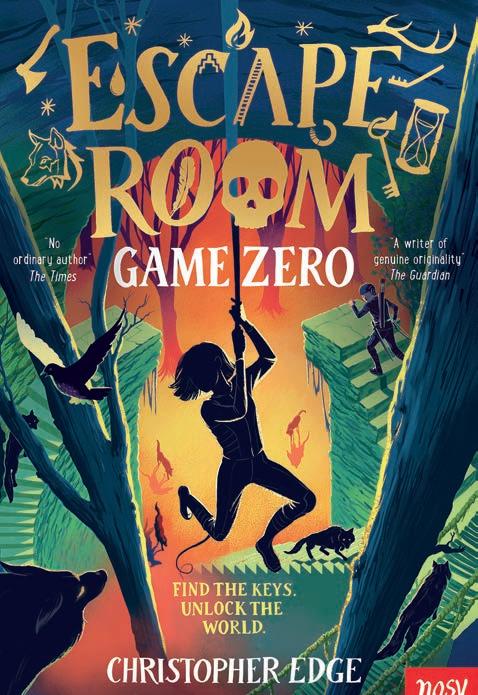
9+
by Christopher Edge NOSY CROW, £7.99
A book for lovers of pacy adventures and games, Escape Room takes readers into a whole other realm. Eden thinks it's the end of the world when the sky turns black with a huge flock of birds. But then she is transported to The Escape, a game no one else knows about. Faced with seemingly endless puzzles, challenges and dangers, she meets fellow traveller Ted. Together they go on an epic adventure to find the keys that will finally reveal the secrets of The Escape.

by Donna Ashworth
illustrated by Eirinn McGuinness TEMPLAR BOOKS, £16.99
The debut children's collection by the UK's bestselling poet – delightfully illustrated by Eirinn McGuinness – brings words of comfort, hope and solidarity. There are poems about the seasons, friendships, siblings and quirkier takes on life – 'Pineapple Pizza' and 'Hopetimism' among them. Poems are light and accessible for younger readers, but don't shy away from di cult subjects. There's an index grouping poems by theme, including grief, change and emotions, and with a note for parents/carers and teachers to introduce the collection.

by Ben Hoare
illustrated by Nina Chakrabarti NOSY CROW, £12.99
Published in collaboration with University of Cambridge as part of Nosy Crow's new Think Big series, Secrets of Bees takes you inside the hive. But you also go beyond to explore the many other varieties, including miner, carpenter and the elusive Wallace's giant bee of Indonesia. The book considers life cycles, habitats, food, honey production and what it feels like to be a bee, also explaining why bees sometimes sting and providing tips on how we can all help protect our vital pollinators.

by Justin Somper illustrated by Teo Skaffa UCLAN PUBLISHING, £7.99
The third book in Justin Somper's swashbuckling series sees Barracuda Class in disarray when they discover a favourite teacher is an enemy agent for the League of True Pirates (LOT P). Our protagonists get into all sorts of hot (and cold) water in the chaos that follows. Jacoby suspects one of his classmates may be LOT P’s next target and Jasmine sets out on a dangerous sailing mission. Neo, meanwhile, follows a treasure-trail leading to a sword with untold powers. In the right hands, it could turn the tide in their favour.

This lavish book created by celebrated French authorillustrator Rébecca Dautremer has received warm praise, so it's a treat to see an English edition. It celebrates the life and times of one unassuming white rabbit through 12 illustrated scenes and longer narratives, interspersed with captioned photo-album style illustrations. We learn about Jacominus' upbringing, friendships, travels, hopes and dreams – also good times and bad. There's a dash of philosophy in the telling and it's a beautifully drawn portrait with a rich theme about living a full emotional life. by Rébecca Dautremer translated by Charis Ainslie POST WAVE, £16.99







by Mike Barfield
Illustrated by Franziska Höllbacher
TEMPLAR BOOKS, £10.99
Blue Peter Award-winner Mike Barfield is back with a sequel to his book about wild inventions. This time the focus is on extraordinary, weird and downright funny jobs through history, all told in a comic-strip format. Jester, body double and stage farter are in there, but so too chariot racer, pirate and Incan runner. There's a cast of fascinating real-life characters, including Harry Houdini, Marie Tussaud, African American stunt pilot Bessie Coleman and Zazel, Victorian daredevil and the original human cannonball.

by Jennifer Claessen
UCLAN PUBLISHING, £7.99
Combining myth, sun-drenched location and adventure, Netta Becker and the Timeline Crime has a holiday flavour – perfect summer combination. When Netta and her history-mad brother Remy end up in a Cretan villa for the summer, she's not too happy. But then the vivid dreams begin and she's transported to Ancient Greece. King Minos is preparing to open his labyrinth and, with rumours of a monster inside, Netta and her brother have a mystery to solve or she might end up as ancient history herself.

5+
by Eoin McLaughlin
Illustrated
by
Guilherme Karsten
NOSY CROW, £12.99
The author of The Hug is back with a tale about the tree that became this very book. It details how the pine cone dropped from the tree, was eaten by Derek the squirrel, moved around by Barbara the beetle and finally put down roots to grow. Then this magnificent tree was cut down to become a story that can be enjoyed, passed on and remembered. There's an audiobook to add to the pleasures of a lovely read-aloud story for young readers.

by Jules Howard
Illustrated by Gordy Wright
NOSY CROW, £14.99
Children take charge of their future in this new book by zoologist Jules Howard. Opening with 'Blob Beginnings' as Dickinsonia in the prehistoric oceans, readers choose one of three options to evolve into. The wild options continue throughout the book and readers can get more information about evolution's survivors (tiger, chicken, hagfish) and the many that became extinct. It's a clever approach to a complex subject, information rich and with engaging species narratives that present evolution as an adventure through time.

























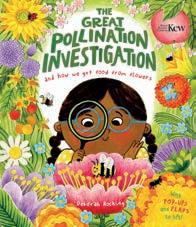
by Deborah Hocking TEMPLAR,
£14.99
Whith lush illustrations by Deborah Hocking and expert-reviewed text from the Royal Botanic Gardens, Kew, this interactive book features lots of fun pop-ups and flaps to bring the wonders of plants and gardening to life. It's a truly interactive read, with lots of fascinating science for young gardeners and nature lovers about the myriad ways pollen is spread. It includes a hands-on science investigation and instructions on how to make a special wand to explore your own garden and become a pollination investigator.

by Terri Libenson HARPERCOLLINS, £9.99
The latest book in this hugely successful graphic novel series centres on an end-ofyear camping trip for the class. These days, Emmie doesn't feel entirely invisible – well, not to her best friends or her crush, Tyler. But Joe is no longer landing great pranks as class clown. When this unlikely duo find themselves stuck together on the trip, they expect the worst, but something unexpected happens.

by Michael Hall HARPERCOLLINS, £12.99
Subtitled 'A Story About Kindness', this book has fun illustrations and minimal text – and the story does pack a powerful punch about the value of empathy. Badger is not coping at all well, for he starts bullying his friends Frog, Moose, Elephant and Bear. While it would be easy to retaliate in kind, they get together and teach him a lesson about kindness. Then, when Bear needs a little extra support, Badger comes good as a friend.

by Joseph Elliott
illustrated by Nici Gregory PICCADILLY PRESS, £7.99
The sequel to Nora and the Map of Mayhem sees our grey-haired protagonist called on to save the day, again. When Nora gets invited to a fancy dress party she thinks that's the worst of it, but then her friend Grizzler goes missing. After she finds his boat wrecked, she launches a rescue mission, only she doesn't expect the great-grandchildren Atticus and Autumn to be on board as stowaways. With monsters and dastardly villains to overcome, our OAP dynamo shows the young ones how it’s done.



Billund in Denmark is the home of Lego – and it’s an excellent family destination for fans of the brick
PENDLE HARTE





At the gate at Heathrow we’re surrounded by small children. It’s the fi rst week of the Easter holidays and there’s only one reason for so many families to be flying to Billund, a small airport in the rural east of Denmark. In fact, it’s the same reason that the airport exists. Billund is the home of Lego, and the enduring appeal of the plastic brick has made this small town into an international destination. And today, the airport that was originally built to take Lego all over the world is now used to
bring people to Lego. Not only is this the gateway to Legoland, but also to the newer Lego House, a vast ‘experience centre’ dedicated entirely to the humble brick. Thanks to Denmark’s e cient public transport system, we’re in the centre of Billund just a few minutes after landing. Actually, we could almost have walked here. Expecting Billund to be entirely Lego-themed, we’re a bit surprised to fi nd that there are no Lego street signs, theme cafes, shops or even billboards. Instead, it’s a small, quiet place – quite short on restaurants and bars and dominated by a vast white monolith that turns out to be



the Lego House. The Legoland theme park is on the outskirts of town, with its own hotel and eateries. Our hotel, The Lodge, is comfortable and surprisingly lacking in any references to Lego, though we all know that everyone is here for the same reason. Once inside the Lego House, it all begins to make sense. It’s a whole Lego world, brilliantly presented to appeal to all ages, obviously to people already obsessed with Lego, but also to people who aren’t. It is a vast and cleverly designed building, a series of staggered blocks that itself resembles a series of Lego bricks. Inside the light and airy space are 25 million lego





pieces, most of them here to be played with, spread over di erent colour-coded zones in light-fi lled areas. It could so easily be hell for parents and overwhelming for children, but thanks to its ingenious design, it’s not. You need a whole day to visit really, because there are so many things to do. We start in the basement, where there’s an exhibition about the history of Lego. It’s a good story, and advertising artwork from the 1980s, ‘90s and ‘00s will be familiar to most of the parents visiting. In brief, Lego was founded in 1932 by Billund carpenter Ole Kirk Christiansen and, by 1980, it had become a global leader in the toy world.

On the first floor, there’s a spectacular model world in Lego. Elaborate miniature street scenes include cityscapes with moving trams, trains and buses; cranes and construction activity, fairgrounds with moving rides and flashing lights, ports with shipping containers loading and unloading, ski resorts with working cable cars, river cruises, helipads –and everywhere are busy little Lego people sitting in cafes, getting into cars, buying flowers, sunbathing on rooftops, putting out fires, driving ambulances and loitering on Lego pavements. The detail is mindblowing.
Then there’s the stop-motion station, where we have 15 minutes to create a small film at individual stations, each with a selection of backdrops and various figures and costumes to work with. We choose the jungle, and are proud of our stop-motion version of I’m a Celebrity, complete with Ant and Dec, plus a few colourful characters arriving in style. Other activities include making lego fish and scanning them into a digital aquarium, constructing Lego flowers and adding them to a large display, and programming Lego robots. Everywhere are small Lego vignettes: recreations of historical interiors, say, or model trees made of millions of bricks, or enormous Lego dinosaurs, and there are lots of pieces submitted by Lego fans all over the world. A vast Lego waterfall is built from almost two million bricks. Various stations – known as Creative Labs – allow for free play with more bricks

than anyone has ever had access to before, whether children want to contribute to communal creations or work on their own. And when hunger calls, there’s a Lego cafe, sta ed by Lego robots that deliver your food in large plastic bricks, and everyone takes home a small chef minifigure.
We leave with small paper bags containing freshly made Lego pieces

‘Lego is a language’, they say, and with its infinite potential for creativity and innovation, they’re not wrong”
that we’ve witnessed coming o a mini production line. ‘Lego is a language’, they say, and with its infinite potential for creativity and innovation, they’re not wrong. We spend the best part of the day at Lego House, and as we exit the lift on the roof into the sunshine, the building comes into its own. Brightly coloured zones on di erent levels are dedicated as a series of playspaces in what feels like a futuristic otherworld with striking architectural beauty. Set against a blue sky, it’s an impressive sight.
The next day we brave Legoland, which is a more relaxed version of the Windsor theme park – of which we have varyingly positive recollections – but we much enjoy the model village. This includes the Taj Mahal, the Pyramids, the Ei el Tower and other global icons alongside miniature versions of innovative modern European housing developments. Copenhagen’s Royal Palace and a working model of Billund airport itself, are among them. The rollercoasters are fun, the queues are minimal and the whole experience is great. No wonder we encountered all those families at Heathrow –they knew that Billund is the place to be.
legohouse.com


From family fun and wild adventure to adults-only escapes, the UK offers a huge choice of camping options. We asked the experts at Pitchup.com to pick six treasures for an idyllic summer break

Forget close to the waves, this site in Budleigh Salterton, Devon boasts its own stretch of sand. It’s an idyllic spot where you can enjoy rockpooling and fishing or hire a kayak, rowing boat or motorboat and venture out to sea. Refreshments are also available – including doggy ice-cream, which pooches are welcome to enjoy from the decking although they are not allowed on the beach itself.
This iconic bay has a sand and pebble beach, backed by red Devonian sandstone cliffs, with views across to two further stacks. It sits within the East Devon AONB, and the South West Coast Path runs directly past along the fossilhunters’ favourite Jurassic Coast.
While Devon’s scenery and cream teas offer good reasons to get out and explore, there are a good range of activities on site include a large pool complex with splash zone, indoor and outdoor play areas, crazy golf, games and amusement arcades. Usefully, there’s a supermarket, restaurant and takeaway. Pitch essentials: Electric grass tent pitch for up to 6 people from £20 per night.
Located in a secluded south-facing field with simple facilities, this farm camping site scored a full ten out of ten in reviews from guests staying in 2024. Young children can spend time feeding and petting the resident alpacas, goats, sheep, chickens and rabbits, and it’s a great opportunity for them to learn about animal care and farm life.
If the animal magic wears o or they need to let o steam and make a noise, there’s also a handy secure children’s play area with tennis rackets, space hoppers, footballs and nets.
There are just six pitches (for tents, touring caravans or motorhomes), as well as toilets and a shower, dish washing area and a small on-site shop for freshly laid eggs and logs for the campfire.
Located around 20 minutes south-east of Chester, the site is close to a host of family-
friendly attractions including the Ice Cream Farm at Tattenhall (the world’s largest ice cream shop with indoor and outdoor play attractions). There’s also the Crocky Trail, a mile-long adventure path with additional slides and rides. Both are within ten minutes’ drive of the campsite. Chester Zoo is under half an hour’s drive and the city itself has medieval galleried shops, Roman history and city walls to explore.
Pitch essentials: Pitches for up to 6 people from £30 per night (2-night minimum).

Holidaying with other families keeps everyone entertained. To up the pleasure, head to a smaller glampsite where your group can have exclusive use. Hengrave Meadow Glamping, on the edge of a pretty village in rural Norfolk fits the bill perfectly, with three fully furnished bell tents, each sleeping up to four, in a gorgeous meadow with small pond. Wellbehaved dogs are welcome, too.
Each tent comes with its own covered outdoor kitchen equipped with camping stove and utensils plus a private shower and toilet in a converted shepherd’s hut. There’s a communal pot wash and fridge in a converted stable with power points for charging phones – you’ll also find a small library there.
Hengrave Meadow is 30 minutes from the Norfolk coast, the ‘fine’ cathedral city of Norwich and the Norfolk Broads, making this an excellent base to explore the county of big skies. The nearest shops and pubs are in Reepham, half-an-hour’s gentle cycling using one of the courtesy bikes.
Nearby attractions include dinosaurthemed adventure park ROARR! (seven minutes’ drive). BeWilderwood treehouse and play park and Pensthorpe are close by.
Pitch essentials: Bell tent for up to 4 people from £150 per night.



Escape the everyday, and the children, with a stay at a luxury shepherd hut located on a 270-acre farm in the Chilterns. There are two huts, each containing everything needed for a cosy break for two, including a double bed, ensuite shower and a kitchenette with microwave, hob, fridge and kettle. Outside, each hut has a delightfully private wood-fired hot tub.
The huts’ namesake red kites are in abundance in this part of the world, so it’s worth taking binoculars for a closer look, although dozens can easily be seen performing acrobatics overhead. Skylark and curlew are regularly spotted thanks to the owners’ commitment to schemes that support ground-nesting birds. Other local wildlife includes barn owls, kingfishers, otters, hares and deer.
There are plenty of walks and trails close by, including a link path to the Phoenix Trail cycle route. Guests can also fish on the River Thame, which runs through the farm. For o -site treasures, Waddesdon Manor, Cliveden House and Blenheim Palace are all within half an hour’s drive. For a real treat, book in to Le Manoir aux Quat’ Saisons – just ten minutes’ away – for a Michelinstarred meal.
Pitch essentials: Shepherd hut from £280 per stay for 2 adults (2-night minimum).

If exploring stunning (and uncrowded) beaches and hiking remote trails before building a campfire to cook up dinner sounds like a perfect way to spend quality time with the family, head for the Afan Valley to this family-run spot known as ‘The Great Welsh Adventure’. Located on top of a hill inside the Afan Forest Park, with far-reaching views over the surrounding terrain, there’s an extensive hand-built wooden play area on site as well as a bar and regular live music. Amenities include a shower block and washing-up cabin, and there’s also an undercover barbecue area with hanging
barbecues and tables – handy if the temperature drops or the rain falls. There are spectacular walks and mountain bike trails to explore from the site. Alternatively, go for adrenalin experiences by ziplining at Zip World Tower – home to the world’s fastest zip line and the UK’s only underground bouncy playground. Hiking and horse-riding opportunities in the Brecon Beacons add to the adventure of a stay here. Complete a family challenge with a walk up, Pen Y Fan, the highest mountain in South Wales, or spend a day on the Six Waterfalls Walk to see the full force of nature.
Pitch essentials: Non-electric tent or motorhome pitch for up to 5 people from £22 per night.
Close to standout attractions, including Clearwell Caves in the Forest of Dean, this site has plenty to see and do whatever the weather. With a free gym, sauna and steam room, as well as an indoor pool with a kids’ area, basketball court, mini golf and plenty of walks and cycle routes, daytimes can be filled with water and woodland fun. Evenings are sorted too, thanks to a choice of on-site restaurants and live entertainment.
The site is popular with camping regulars and welcomes all varieties of camper and glamper, with pitches for campervans, touring caravans and tents. Four-legged visitors are welcome – the dedicated dog exercising area even has a canine assault course. There are also plentiful great walks on and around the site.
The local area o ers plenty to see and do, from iconic Tintern Abbey to canoeing or kayaking along the River Wye at Symonds Yat. Under two hours’ drive from Birmingham and 40 minutes from Gloucester, this is a popular stop-o point for tourers journeying on to South Wales, Devon and Cornwall. Pitch essentials: Pitch for up to six people from £28 per night.
To book these sites or search more than 6,000 others listed by location and special features, visit pitchup.com







The most beautiful beach and a gloriously relaxed vibe make Turks and Caicos irresistible – especially as guests of Wymara















Turks and Caicos Islands delivers a Caribbean experience without the crowds. This ribbon of 40 islands and cays, eight of them inhabited, sit south of the Bahamas in the Lucayan Archipelago – so geographically within Atlantic not Caribbean waters. While low key for tourism, Turks and Caicos punches above its weight for plaudits – notably, topping multiple lists for world's best beach at Grace Bay.
We are guests of Wymara Resort + Villas on Providenciales (locals call it Provo) giving us direct access to this celebrated beach. Like Turks and Caicos, Wymara is a heavy hitter for awards. You'll fi nd it on all the best lists, including Forbes, Tripadvisor and Conde Nast Traveler. Guests rave about serenity and superlative service in a picture-perfect romantic location. We're lucky guests indeed, experiencing both its luxurious villas and the boutique resort, a few minutes' drive away.


Even arriving at Providenciales Airport feels like stepping down a gear. We've been advised not to bother with a taxi because everyone takes the minibus – and so we join returning islanders and visitors, a convivial crew happy to be paradise side. Everyone knows Wymara Resort, but the Wymara Villas + Beach Club is newer and there's some debate among our fellow travellers as to where precisely it's located. Thankfully, our driver knows the way – we're dropped o with happy holiday wishes within minutes. As arrivals go, this couldn't be easier, and so it continues. After the swiftest check-in, we're whisked up the hill by golf cart to our one-bedroom pool villa by our personal concierge. Our sun-drenched space is dazzling, ultra-modern and sleek with total privacy. Doors open to our outside deck – ultimate serenity spot with dining area, private plunge pool, shady loungers and views of glittering blue ocean just down the hill. Inside, the villa is a design marvel with a huge ocean-facing bed, cosy sofa plus a kitchenette so well imagined that we could cook up a feast, should we so desire. The








bathroom gives more superb views of the blue ocean below from its walk-in shower.
Refreshed after a quick dip in our private pool, we head out to a reception and dinner at one of the six-bed villas recently added by Wymara. While our space feels roomy, this is positively palatial – huge pool, incredible entertaining spaces and direct access down to the ocean via private steps. We are treated to a lavish feast created by the inhouse chef team before retiring replete.
Next morning, breakfast gets delivered discreetly to our hilltop deck and then we head down to the chic Beach Club, where energetic souls swim laps, play tennis or try pickleball. We're tempted by the fantastic in-ocean pool. Accessed down wide steps from the jetty, it's a vast and deep seawater marvel hewn from rock. You can swim lazy laps to your heart's content and then recharge at the Tiki Bar, where food and drinks are served all day. Sundowners here provide the best sunset views.
One evening, before heading out, we have a sound bath therapy on our deck. It
is an out-of-body experience that leaves us simultaneously relaxed and recharged. This, like all the spa treatments, comes to your villa if you don't want to go to the spa. Sustainability and healing are key tenets, with treatments from beauty-insider favourite 111SKIN from London and islanddeveloped Wildflower Skincare Lab. With the latter, flowers used in products are grown right here on resort.
Sustainability is a top concern resortwide – and with Green Globe Certification to prove it. There are generous ongoing Wymara contributions supporting initiatives to maintain what makes Turks and Caicos unique – including its spectacular reef system, third largest in the world. No visitor to this pristine environment would ever argue with that.
After a couple of days in idyllic villa seclusion, where we don't need to lift a finger or go anywhere (we're reliably informed that's precisely what a fair few guests come here to do), we move Resort side to an Oceanfront Suite. This is another brilliantly designed space, with vast living room and kitchen and
separate bedroom with double-height doors you can close (useful for hosting guests). There's a glamorous in-bedroom bathtub for leisurely soaks, with wonderful bathroom adjoining. But the biggest luxury is the uninterrupted ocean vista from our terrace.
Amazing Grace Bay Beach – there is no better description. It is vast, curved and wide, and stretching into what seems like infinity in both directions. It has the softest sand we have ever walked on and is blissfully uncrowded. There are swimmers and loungers dotted about and couples walking the shore – it's a dreamy stroll along this beautiful bay with its vivid blue waters.
Life at Wymara Resort happens on or around the beach, unsurprisingly. Pink Bar o ers the best cocktails and a great bar menu fresh from the laidback Blue Water Bistro right next door, while the cosy loungers and fire pit beyond – plus regular beach barbecues – tempt guests to linger barefoot in the sand long after the sun sets.
For even finer dining, Indigo is top-rated across the island and far beyond, with multiple
"Amazing Grace Bay Beach – there is no better description – has the softest sand we have ever walked on and is blissfully uncrowded"




culinary awards. Menus o er delicious fish and seafood specialities, always with emphasis on provenance and sustainability (Australian executive chef Andrew Mirosch is also an avid fisherman). There's a brilliant range of vegan and wellness options, too, and simply everything – from shrimp and local mahimahi to the fabulous array of steaks – is on point for taste and presentation. The dessert menu deserves special mention for housemade ice creams and sorbets, chocolate lava cake and deconstructed bano ee pie – divine indulgences one and all.
In fact, divine indulgence is the best way to describe Wymara. Whether you are resort or villa side or (like us) experience the pleasures of both, this is an enchanted retreat on the most beautiful island. It delivers perfect down time – quietly luxurious, supremely relaxed, and with the softest sand and bluest ocean. And yes, amazing Grace Bay deserves that crown for world's best beach.
* Rooms from £631, inc breakfast. BA flies to Providenciales via Nassau. wymara.com




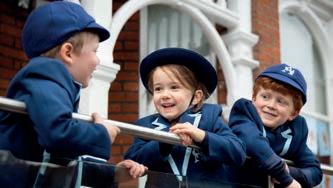






At Sarum Hall School we believe that the spirit of every child should be nurtured; that happiness gets results; and that success is ensuring every girl achieves their personal best.
We are a modern, independent girls prep school in London’s Belsize Park. We focus on each girl as an individual, and inspire them to fulfil their potential and encourage them to achieve excellence.
Individual talents are nurtured, and we instil a strong sense of purpose to every girl, allowing them to explore our wonderful world with confidence.
foundations
Miss K Coles - Headmistress
Sarum Hall School 15 Eton Avenue, London NW3 3EL 020 7794 2261
admissions@sarumhallschool.co.uk www.sarumhallschool.co.uk





From riding and football to karate and hip-hop, children’s passions are marvellously mercurial, so how much do you commit to their hobby time?
By RACHEL WEBB
No parent wants to stifle latent talent or extinguish the dreams of a child set on riding for Team GB, scoring the winning goal at Wembley or wowing the Royal Albert Hall with electric dance moves. But nurturing childhood passions takes time and cash – and outlay all too often outlasts enthusiasm. A 2019 study by the consultancy GKP estimated average costs of £1,500 a year and three hours a week were devoted to each child’s out-of-school pastimes by the UK’s devoted parents.
Children are like sponges, so it’s natural that their interests wax and wane. Support and encourage, but don’t overcommit until you are sure of reasonable staying power. This is where well-run school extracurricular programmes are so invaluable, o ering taster sessions
and ‘have a go’ opportunities that boost confidence and expand horizons while also helping children shortlist favourites.
Out-of-school clubs or classes can be a di erent matter, so don’t sign up without reading the small print. Look for settings that don’t demand large up-front commitments of cash or time, o er some flexibility on attendance, and give free or discounted trial sessions. Use the parent grapevine for feedback – is this a fun place that children look forward to returning to each week?
Successful out-of-school commitments often happen when children join a club or session with friends or siblings. This may also mean parents share the burden of transportation and it guarantees buddies who can ease social pressure and build confidence with unfamiliar settings and challenges.
Mustering a group can also bring good deals that ease the cost – sibling discounts
are not uncommon, and joining forces with other parents to share and pass on kit and equipment makes financial sense.
With a full school schedule and ever-growing homework commitments, children need down time – so no wonder extracurricular overload is a perennial topic on parent forums. It’s fine to have a frank conversation with your child about taking away an activity, with the reassurance that they can pick it up again later. Giving an either-or choice on which hobby to drop will help them focus on what they really enjoy.
Children can and do go o things overnight. Sometimes it’s an age and stage shift, but often you’ll have no idea why. Forcing a child to carry on with activities they no longer enjoy is counter-productive, so even if your private daydreams of their victory with Team GB or dance moves on the Albert Hall stage crumble to dust along with the hobby, bow out gracefully. Then console yourself with the thought of the free evenings you’ll be getting back.
“NURTURING CHILDHOOD PASSIONS TAKES TIME AND CASH – AND OUTLAY ALL TOO OFTEN OUTLASTS ENTHUSIASM”








